0 Comments
Author Book Signing Event at Waipuna Conference Centre, Auckland on Saturday, 16 August, 5-6pm12/8/2014 If you're interested, a round-up of reviews from this week's book tour for All Quiet on the Western Plains can be found here: http://www.isabellahargreaves.com/news-and-events.html. The winner of a copy of the novella has been drawn. Congratulations if it was you!
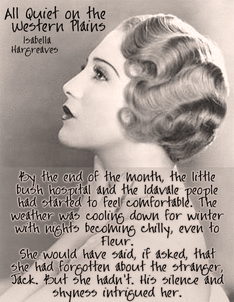 Jack Edgarson: The Great War ended six years ago, but not for me. I relive it in my dreams. If that isn’t enough for any man, sometimes I wake up miles from home after sleep-walking. The time I found an axe in my hand convinced me to move to western Queensland – beyond the end of the railway line. It’s safer for others that way. Now I’m a cattleman running my property with just a couple of temporary stockmen and a cook. I keep to myself. It’s best that I stay away from people. Well, that’s what I thought until Fleur Armitage, an English nurse, turned up in town. Now, I’m torn between keeping true to my promise to stay clear of people and my compulsion to see her, to hear her soothing voice, to inhale her rose scent that reminds me of gentle summer evenings in England before my war began. Fleur Armitage: I’ve come to western Queensland to forget the past. As a nurse, I worked in clearing stations and general hospitals during the Great War and saw a lot of suffering and death. My fiancé was killed in action in 1918 and my sister and her daughters died in a bombing raid on Margate in England. I went home to mother in 1919, but she caught Spanish Flu and soon passed away, like so many others. I felt adrift in the world and didn’t dare get close to anyone in case they were taken from me. Until Jack Edgarson. He saved my life. Now I want to know who he is – to solve the enigma. He’s not making that easy. 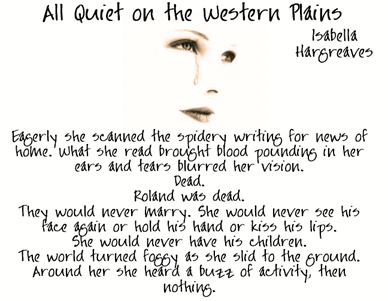 Join me on tour 15-21 May to launch All Quiet on the Western Plains. As usual there's a book giveaway drawn at the end of the tour. "One war, two battle-scarred hearts, one chance for happiness. " First stop is: http://bookwormbridgette.blogspot.com/2014/05/blog-tour-all-quiet-on-western-plains.html 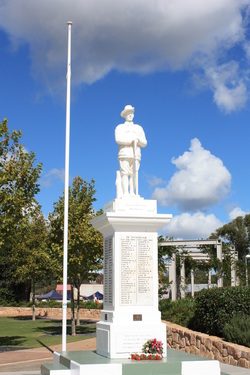 Memorial, Crows Nest, Queensland. Memorial, Crows Nest, Queensland. Several years ago, I started researching three Brisbane men who had different experiences of World War I. One served in an Engineers Corps – earning a Military Medal; another served as a motor cycle messenger in the Motor Transport Corps and was ‘Mentioned in Despatches’ in 1918; while the third was an ambulance driver in the Balkans – a theatre of the war about which we rarely hear. They also all served on the Australian home front during WWII. Researching these men was made easier by the wonderful resources provided by the National Archives of Australia. Digitised copies of the service records for Australian WWI servicemen are available online – free - making researching your ancestor, or person of interest, simple. These can be found here: http://www.naa.gov.au/collection/explore/defence/service-records/army-wwi.aspx World War II records are similarly available online, if someone has paid for the initial digitisation. If the record is not yet digitised, getting them done costs a nominal fee. Once you know the division and unit in which the soldier served, it is then possible to find the battalion's history and/or diary which tell where the unit was located at various times. In commemoration of the 100th anniversary of the start of World War I later this year, the Imperial War Museum has online exhibitions and projects underway. Go to: http://www.iwm.org.uk/history/first-world-war. Similarly, the Australian War Museum has new exhibitions to commemorate the centenary - see them at http://www.awm.gov.au/1914-1918/. Inspired by reading autobiographies and diaries of Australian soldiers who served in World War I, my novella All Quiet on the Western Plains explores the aftermath of that conflict for an Australian soldier and an English nurse who move to the western plains of Queensland to escape their experiences. Instead, they find each other and hope for the future. Available 1 May 2014 from Amazon and other good book sellers. Have you researched an ancestor who served in World War I? I would love to hear about him or her. 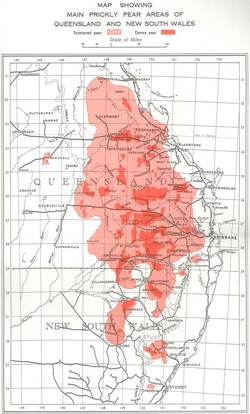 Source: A P Dodd, 1940. Source: A P Dodd, 1940. During the 1920s, the biggest concern for many people in country Queensland, aside from the weather, was the rapid spread of the pest cacti commonly known as prickly pear. From Mackay in central Queensland to central New South Wales, these plants were multiplying and choking the land. They had been introduced into Australia from North and South America during the nineteenth century. Warnings of their capacity to multiply and make good land useless began in the 1870s, but it wasn't until the 1890s that bylaws and legislation requiring their removal were created. By the early twentieth century, the need for a biological control of the pest had been recognised. Although an effective poison to kill the cacti was determined in 1916, obtaining it during World War One was difficult and Australia's manpower and the money to control prickly pear were employed overseas. Finally, in 1919, the Commonwealth Government and the governments of Queensland and New South Wales established a joint project, to discover and introduce into Australia biological pests of prickly pear, to control its spread. Achieving this goal was to take 10-20 years, but the introduction of Cactoblastis cactorum and a number of other parasites of the cacti, was an outstanding success. Not all of Queensland was affected by prickly pear. Open plains were generally spared the infestation - among them the plains of western Queensland. It is here that my latest book, All Quiet on the Western Plains is set. The characters therefore weren't involved in the struggle to control prickly pear that was going on in much of rural Queensland in 1924. Does your family have a story from the bad old days of Prickly Pear? I would love to hear from you. All Quiet on the Western Plains - available 1 May 2014 - from Amazon, Steam eReads and Book Srand. References: Dodd Alan P. The progress of biological control of prickly pear in Australia. Commonwealth Prickly Pear Board, Brisbane, 1929. Dodd Alan P. The biological campaign against prickly-pear. Commonwealth Prickly Pear Board, Brisbane, 1940. Dodd, Alan P. ‘The Conquest of Prickly-Pear’. RHSQJ, 1945, 3, 5, pp. 351-61. Mann, John. The Naturalised Cacti in Australia, Queensland Lands Department, Brisbane, 1970. 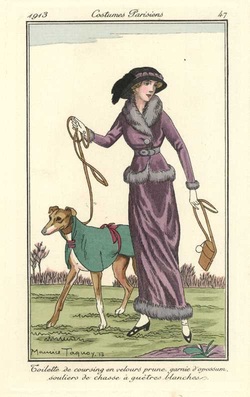 While working on my latest book, All Quiet on the Western Plains, I looked at fashions in the 1910s and '20s, and have since found some lovely French fashion studies from the period advertised online. They are from hand-painted pochoirs (stencils) - using gouache and watercolour - dating from circa 1912- circa 1925. I think the fashions are gorgeous! See what you think. Go to the following link, if you're interested (b.t.w. I have no connection to this business) : https://www.antiqueprintclub.com/c-23-fashionpochoir.aspx If you would like further information about pochoir and the journal in which they were published (Gazette Du Bon Ton - Mode et Frivolites) see: http://antique-print-club.blogspot.com.au/ |
Archives
June 2024
Categories
All
|
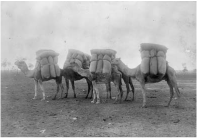
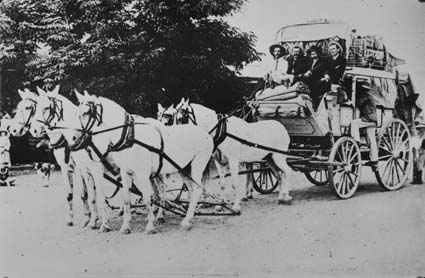
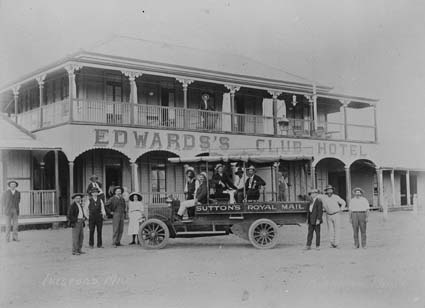
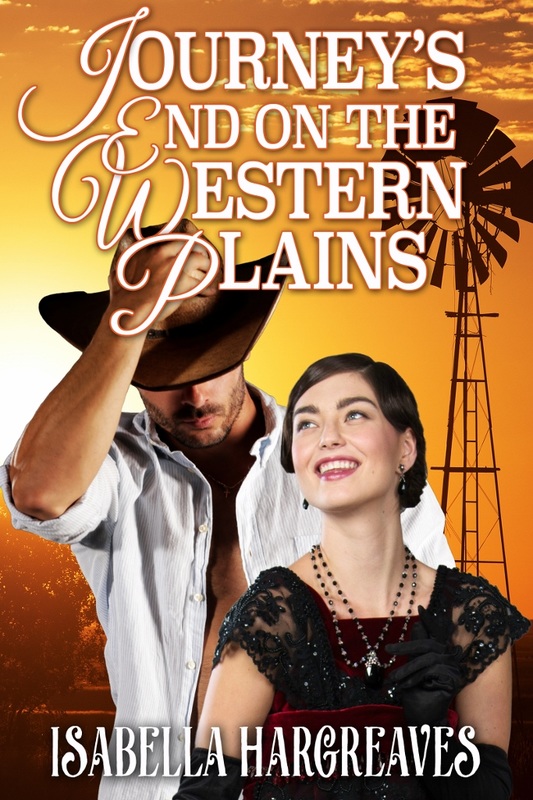
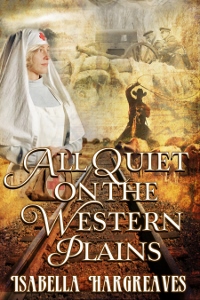

 RSS Feed
RSS Feed